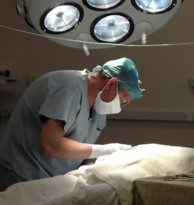Reducing Complications in Radical Mesothelioma Surgery
 A team of doctors in India have demonstrated how radical mesothelioma surgery may be made safer by managing body temperature and other parameters during the procedure.
A team of doctors in India have demonstrated how radical mesothelioma surgery may be made safer by managing body temperature and other parameters during the procedure.
In a new report, they detail their success performing lung-removing surgery and heated chemotherapy on a 58-year-old man with malignant pleural mesothelioma.
The Controversy Over Mesothelioma Surgery
Extrapleural pneumonectomy (EPP) is considered the most radical form of mesothelioma surgery.
It involves not only the removal of the diseased pleural lining around the lungs, where mesothelioma starts, but also the closest lung, all or part of the diaphragm, the lining around the heart, and other at-risk tissues.
The procedure is often followed by a wash of heated chemotherapy drugs (HITHOC) to kill remaining mesothelioma cells. EPP with HITHOC is lengthy and extensive and many doctors no longer advocate this type of surgery for mesothelioma because of its high risk of complications and death.
Making EPP Safer for Mesothelioma Patients
Although the EPP/HITHOC procedure is risky, some studies have shown that patients who survive the complications of surgery may experience longer mesothelioma survival than patients who undergo more conservative surgical approaches.
In a detailed new report, a team of anesthesiologists and surgeons with Manipal Hospital in Karnataka, India explain the measures they have put in place to counteract some of the most dangerous aspects of pleural mesothelioma surgery and improve outcomes for their patients.
Maintaining Body Temperature is Key
Because rapid changes in body temperature during surgery can trigger serious problems such as heart attack, a primary goal of the Indian team was to maintain the patient’s body temperature during the procedure.
Although the EPP operation lasted more than 9 hours, during which time a mesothelioma patient’s core temperature can drop dangerously low, the team kept their patient’s temperature normal using warming blankets and other techniques.
During the hour of heated chemotherapy that followed, the team prevented a dangerous rapid rise in temperature with cold intravenous fluids and a cooling blanket.
They also managed major blood loss by being ready with the right mix of red blood cells and plasma ahead of time and kept a close eye on the input and output of body fluids.
Dr. Jalaja Koppa Ramegowda, an anesthesiologist and the first author on the report, concludes, “Thorough pre-operative assessment and preparation [and] advanced intra-operative monitoring with prompt corrective interventions will help in improved patient outcome.”
A full report of all of the interventions involved in the mesothelioma surgery is detailed in the Indian Journal of Asaesthesia.
Source:
Ramegowda, JK, et al, “Anaesthetic management of extra-pleural pneumonectomy and hyperthermic introthoracic chemotherapy procedure”, December 2015, pp. 807-810





